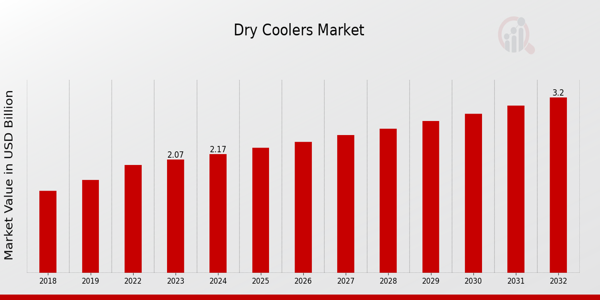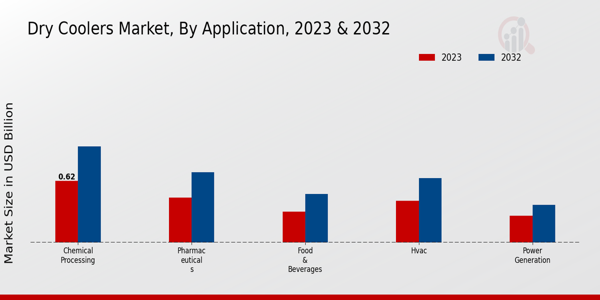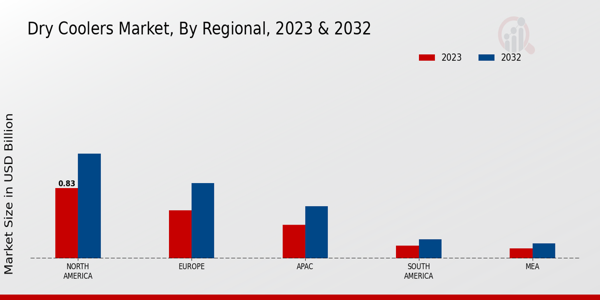Global Dry Coolers Market Overview
The Dry Coolers Market Size was estimated at 2.28 (USD Billion) in 2024. The Dry Coolers Industry is expected to grow from 2.39 (USD Billion) in 2025 to 3.71 (USD Billion) by 2034. The Dry Coolers Market CAGR (growth rate) is expected to be around 4.99% during the forecast period (2025 - 2034).
Key Dry Coolers Market Trends Highlighted
The Dry Coolers Market is witnessing significant growth driven by the increasing demand for efficient cooling solutions across various industries. One of the key market drivers is the rising need for energy-efficient products, as businesses seek to reduce operational costs while enhancing performance. Furthermore, the push for strict environmental regulations is leading industries to adopt technologies that minimize water consumption and reduce carbon footprints. This shift opens doors for innovative dry cooler designs that align with sustainability goals, offering manufacturers a chance to gain a competitive edge. Opportunities to be explored include the expanding use of dry coolers in sectors such as data centers, manufacturing, and HVAC systems.With technological advancements, companies can develop customized and smart cooling solutions that integrate with existing systems. Focus on product differentiation and niche markets, such as portable or specialized dry coolers for specific applications, allows for potentially untapped revenue streams. Collaborations and partnerships can foster innovation, enabling companies to reach new markets and customer segments. Recent trends in the dry coolers market highlight a growing inclination towards modular and compact designs. These designs facilitate easier installation and maintenance, attracting users who prioritize efficiency and space-saving solutions.The integration of IoT technology is becoming common, allowing users to monitor and optimize performance remotely. Additionally, increasing awareness of environmental sustainability is prompting manufacturers to incorporate recyclable materials into their products. Overall, the combination of these trends, opportunities, and market drivers is set to shape the future landscape of the Dry Coolers Market, providing pathways for growth and development.

Source: Primary Research, Secondary Research, MRFR Database and Analyst Review
Dry Coolers Market Drivers
Increasing Demand for Energy Efficiency in Industrial Applications
One of the most significant drivers for the Dry Coolers Market Industry is the growing demand for energy efficiency across various industrial applications. As industries face increasing pressure to reduce operational costs and minimize their environmental impact, energy-efficient solutions are becoming more critical. Dry coolers, which utilize ambient air for cooling instead of traditional water-based systems, are being widely adopted due to their ability to significantly lower energy consumption and operational costs.This consideration towards sustainability is pushing industries such as manufacturing, pharmaceuticals, and data centers to invest in advanced cooling technologies. With the expected growth of the market, businesses are likely to prioritize systems that offer enhanced performance and greater energy efficiency. As regulations regarding energy usage and emissions continue to tighten, the adoption of dry coolers is anticipated to rise, thereby propelling market growth.Additionally, innovations in design and technology in the Dry Coolers Market are further enhancing the performance and reliability of these systems. The integration of smart technology and automation in cooling solutions is also creating avenues for increased market penetration as industries seek to optimize their cooling processes. Such advancements not only lead to improved operational efficiencies but also contribute to a more sustainable future, aligning with objectives to combat climate change.Therefore, energy efficiency is an essential driver that shapes the future landscape of the Dry Coolers Market.
Rapid Industrialization and Urbanization
The rapid pace of industrialization and urbanization across regions is significantly driving the growth of the Dry Coolers Market Industry. As industries expand and new urban centers emerge, the demand for effective cooling systems has surged. Dry coolers are becoming essential in various industrial settings, including food and beverage production, chemical processing, and power generation, where efficient temperature management is of utmost importance.Given the pressure on embracing digital transformation, developments are anticipated to yield improvements and cost savings in the future of drilling processes.
Regulatory Compliance and Environmental Concerns
Another key driver for the Dry Coolers Market Industry is the increasing concern regarding environmental sustainability and adherence to regulatory standards. Governments and organizations worldwide are implementing stricter regulations aimed at reducing greenhouse gas emissions and promoting eco-friendly technologies. As companies strive to meet these regulations, the demand for dry coolers, which offer a more environmentally friendly alternative to traditional cooling systems, is on the rise.The focus on sustainable practices is influencing industries to adopt innovative solutions that comply with environmental standards and contribute to a greener economy.
Dry Coolers Market Segment Insights
Dry Coolers Market Application Insights
The Dry Coolers Market is projected to maintain steady growth, valuing at 2.07 USD Billion in 2023 and expanding to 3.2 USD Billion by 2032. When examining the market segmentation, the Application segment takes on a significant role, with notable revenue contributions from various industries. In 2023, the Chemical Processing sector led the charge with a valuation of 0.62 USD Billion, projected to reach 0.97 USD Billion in 2032. This sector is essential due to the need for efficient cooling in the handling and processing of chemicals, underscoring its majority holding in the market.Following closely, the Pharmaceuticals Application accounted for 0.45 USD Billion in 2023 and is set to grow to 0.71 USD Billion by 2032. This sector's importance is magnified by stringent regulatory standards and the critical nature of maintaining temperature-sensitive products, ensuring its significant presence in the market. The Food Beverages sector, valued at 0.31 USD Billion in 2023 and projected at 0.49 USD Billion in 2032, remains vital for ensuring food safety and quality through effective cooling solutions. In addition, the HVAC Application segment accounted for 0.42 USD Billion in 2023, expected to rise to 0.65 USD Billion by 2032, highlighting the demand for energy-efficient cooling in residential and commercial spaces, which further solidifies its relevance.Lastly, the Power Generation sector, while smaller in scale with a value of 0.27 USD Billion in 2023 and expected to reach 0.38 USD Billion by 2032, still plays a critical role in ensuring optimal cooling for thermal systems, thereby adding to the diversity of applications within the Dry Coolers Market. As the industry responds to an increasing need for energy efficiency and regulatory adherence across multiple sectors, the market displays strong potential for growth driven by technological advancements and rising demand across these pivotal application areas.Moreover, challenges such as fluctuating raw material costs and evolving compliance requirements may influence the overall dynamics of the market, yet they also present opportunities for innovation and development. Overall, the Application segment of the Dry Coolers Market reflects a robust landscape shaped by the diverse needs of each industry, driving forward market growth through varying cooling solutions and regulations.

Source: Primary Research, Secondary Research, MRFR Database and Analyst Review
Dry Coolers Market Cooling Technology Insights
Air-Cooled, Water-Cooled, and Hybrid-Cooled technologies represent the major components of this market. Air-cooled systems are often recognized for their efficiency in a variety of environments, making them a popular choice in commercial applications. Meanwhile, Water-Cooled systems provide high-performance cooling, especially in industrial settings, which has contributed to their significant market presence.Hybrid-Cooled solutions blend the advantages of both cooling types, promising enhanced energy efficiency and adaptability, thus appealing to a broad range of consumers. As booster in technologies and growing awareness of energy consumption drive market growth, the Dry Coolers Market statistics emphasize the increasing importance of these cooling technologies in achieving operational efficiency. The market is expected to experience consistent growth due to rising demands for energy-efficient and cost-effective cooling solutions, alongside the evolving regulatory landscape focused on environmental sustainability.
Dry Coolers Market Design Type Insights
The Dry Coolers Market is expected to showcase steady growth driven by the increasing demand for efficient cooling solutions across various industries. The Design Type segment plays a pivotal role in this market, which can be explored through Compact, Modular and Standard designs. Compact dry coolers are gaining traction for their space-saving features, making them ideal for confined environments. Modular designs offer flexibility and scalability, catering to businesses that require customizable cooling solutions to adapt to variable needs.Standard designs have remained significant, providing reliable and robust cooling for diverse applications. As businesses focus on sustainability and energy efficiency, innovations in dry cooler designs will enhance their effectiveness while reducing operational costs. The Dry Coolers Market revenue is influenced largely by these design trends, which highlight an evolving industry embracing technological advancements and practicality while addressing the challenges of thermal management across sectors. Furthermore, market growth is supported by increased production across industries that heavily rely on cooling systems, signaling ongoing opportunities for expansion.
Dry Coolers Market End Use Industry Insights
The Dry Coolers Market is expected to see significant growth due to increasing demand across various end-use industries. Within the end-use industry, manufacturing is a major driver, given its need for efficient heat exchange processes in production lines. The construction industry also plays a critical role, utilizing dry coolers for maintaining optimal temperatures in buildings and reducing energy consumption. Data centers prominently rely on these systems for cooling, especially as the demand for cloud computing and big data analytics rises.Agriculture demonstrates a significant need for dry coolers to preserve products and optimize irrigation systems, emphasizing sustainability. Overall, the combination of growth drivers from these industries enhances the Dry Coolers Market's revenue opportunities while presenting challenges such as technological advancements and competition within the market space. As of now, emerging trends in energy efficiency and environmentally friendly cooling solutions are gaining traction and may reshape the market landscape in the years ahead.
Dry Coolers Market Regional Insights
North America leads the market, holding a significant share valued at 0.83 USD Billion, and is expected to reach 1.24 USD Billion by 2032, indicating its dominance in the industry due to extensive industrial activities. Europe follows, with a market valuation of 0.57 USD Billion in 2023 and a growth forecast of 0.89 USD Billion by 2032, driven by increasing demand for energy-efficient cooling solutions.The Asia-Pacific region, valued at 0.4 USD Billion in 2023, is anticipated to grow to 0.62 USD Billion by 2032, highlighting its rising industrialization and growing climate awareness. Meanwhile, South America and MEA hold smaller shares with values of 0.15 USD Billion and 0.12 USD Billion, respectively, in 2023, projected to reach 0.23 USD Billion and 0.18 USD Billion by 2032. While these regions represent a minor portion of the overall market, their growth offers opportunities for investment in developing infrastructure. Overall, the Dry Coolers Market segmentation reflects diverse regional dynamics influenced by local industrial demands, sustainability initiatives, and technological advancements.

Source: Primary Research, Secondary Research, MRFR Database and Analyst Review
Dry Coolers Market Key Players and Competitive Insights
The Dry Coolers Market is characterized by intense competition among various key players, each striving to enhance their product offerings and capture significant market share. With the increasing demand for energy-efficient cooling solutions across various industries, companies are focusing on innovative designs, technological advancements, and strategic partnerships to distinguish themselves. The market landscape is shaped by evolving regulatory standards, economic factors, and environmental considerations, prompting manufacturers to adapt and innovate. The competitive dynamics also involve responding to customer needs for reliability, cost-effectiveness, and sustainability, driving firms to refine their supply chains and improve operational efficiencies. As companies navigate these challenges, understanding the competitive positioning within the market becomes vital for sustained growth and profitability.Johnson Controls has established a solid presence in the Dry Coolers Market, leveraging its extensive experience in heating, ventilation, and air conditioning systems. The company is known for its commitment to innovation, continually integrating advanced technology and smart solutions into its dry cooler products. This focus on research and development allows Johnson Controls to offer efficient cooling solutions that meet the varying demands of their clientele, catering to industries such as manufacturing, data centers, and commercial buildings. The company’s strong brand reputation is supported by its reach and the capability to deliver reliable products that comply with international standards. Furthermore, Johnson Controls benefits from effective customer relationships and a comprehensive support network, enhancing its position as a trusted provider in the marketplace.SPX Corporation has carved out a niche in the Dry Coolers Market through its specialization in developing high-quality cooling solutions tailored to various applications. The company's strengths lie in its engineering expertise and ability to customize products that align with customer specifications and industry requirements. SPX Corporation emphasizes sustainability and energy efficiency, aligning its product development strategies with current environmental trends. By focusing on effective thermal management solutions, SPX Corporation meets the growing demand for innovative cooling technologies across sectors such as food and beverage, pharmaceuticals, and industrial manufacturing. The company’s commitment to quality assurance and customer service further solidifies its competitive edge, enabling it to maintain a strong foothold within an increasingly competitive landscape.
Key Companies in the Dry Coolers Market Include
- Johnson Controls
- SPX Corporation
- Aermec
- VentACool
- Tropical Breeze
- Glen Dimplex
- Rittal
- Friedrich Air Conditioning
- Dimplex
- Trane Technologies
- Daikin Industries
- Frigel Firenze
- Thermo King
- Mitsubishi Electric
- Carrier
Dry Coolers Market Industry Developments
Recent developments in the Dry Coolers Market have revealed a growing trend toward energy-efficient cooling solutions, with considerable interest from major players like Johnson Controls, Daikin Industries and Trane Technologies. These companies are focusing on advancing technologies that reduce operational costs and environmental impact. SPX Corporation and Aermec have bolstered their product lines to address the increasing demand for sustainable and reliable cooling systems, catering specifically to industries such as pharmaceuticals and data centers.Additionally, merger and acquisition activities have been notable, with companies like Carrier actively seeking to expand their market presence by acquiring complementary technology firms within the dry cooling sector. The overall market valuation has shown significant growth, attributed to increased investments in smart building technologies and industrial cooling applications. This growth is fostering heightened competition among industry players, driving innovation and improved product offerings. Ultimately, companies are strategically positioning themselves to capitalize on emerging market opportunities while contributing to a greener future in cooling technologies.
Dry Coolers Market Segmentation Insights
Dry Coolers Market Application Outlook
- Chemical Processing
- Pharmaceuticals
- Food Beverages
- HVAC
- Power Generation
Dry Coolers Market Cooling Technology Outlook
- Air-Cooled
- Water-Cooled
- Hybrid-Cooled
Dry Coolers Market Design Type Outlook
Dry Coolers Market End Use Industry Outlook
- Manufacturing
- Construction
- Data Centers
- Agriculture
Dry Coolers Market Regional Outlook
- North America
- Europe
- South America
- Asia Pacific
- Middle East and Africa
| Report Attribute/Metric |
Details |
| Market Size 2024 |
2.28 (USD Billion) |
| Market Size 2025 |
2.39 (USD Billion) |
| Market Size 2034 |
3.71 (USD Billion) |
| Compound Annual Growth Rate (CAGR) |
4.99% (2025- 2034) |
| Report Coverage |
Revenue Forecast, Competitive Landscape, Growth Factors, and Trends |
| Base Year |
2024 |
| Market Forecast Period |
2025- 2034 |
| Historical Data |
2020 - 2024 |
| Market Forecast Units |
USD Billion |
| Key Companies Profiled |
Johnson Controls, SPX Corporation, Aermec, VentACool, Tropical Breeze, Glen Dimplex, Rittal, Friedrich Air Conditioning, Dimplex, Trane Technologies, Daikin Industries, Frigel Firenze, Thermo King, Mitsubishi Electric, Carrier |
| Segments Covered |
Application, Cooling Technology, Design Type, End Use Industry, Regional |
| Key Market Opportunities |
1. Increased industrial cooling demand, 2. Growing energy efficiency requirements, 3. Expanding data center applications, 4. Rising demand for HVAC systems, 5. Technological advancements in design |
| Key Market Dynamics |
1. Increasing demand for energy efficiency, 2. Technological advancements in cooling solutions, 3. Growth in industrial applications, 4. Rising environmental regulations, 5. Expansion of data center facilities |
| Countries Covered |
North America, Europe, APAC, South America, MEA |
Frequently Asked Questions (FAQ) :
The Dry Coolers Market is expected to be valued at 3.71 USD Billion by the year 2034.
The expected CAGR for the Dry Coolers Market from 2025 to 2034 is 4.99%.
North America is projected to have the largest market size, valued at 1.24 USD Billion in 2032.
The Food Beverages application segment is expected to be valued at 0.49 USD Billion in 2032.
Major players in the market include Johnson Controls, SPX Corporation and Daikin Industries, among others.
The Chemical Processing segment is anticipated to be valued at 0.97 USD Billion in 2032.
The HVAC segment is expected to reach a market value of 0.65 USD Billion in 2032.
The APAC region is showing promising growth, with a market value projected at 0.62 USD Billion in 2032.
The Power Generation application segment is expected to be valued at 0.38 USD Billion in 2032.
Key growth drivers include increasing industrial applications and advancements in cooling technologies.

















